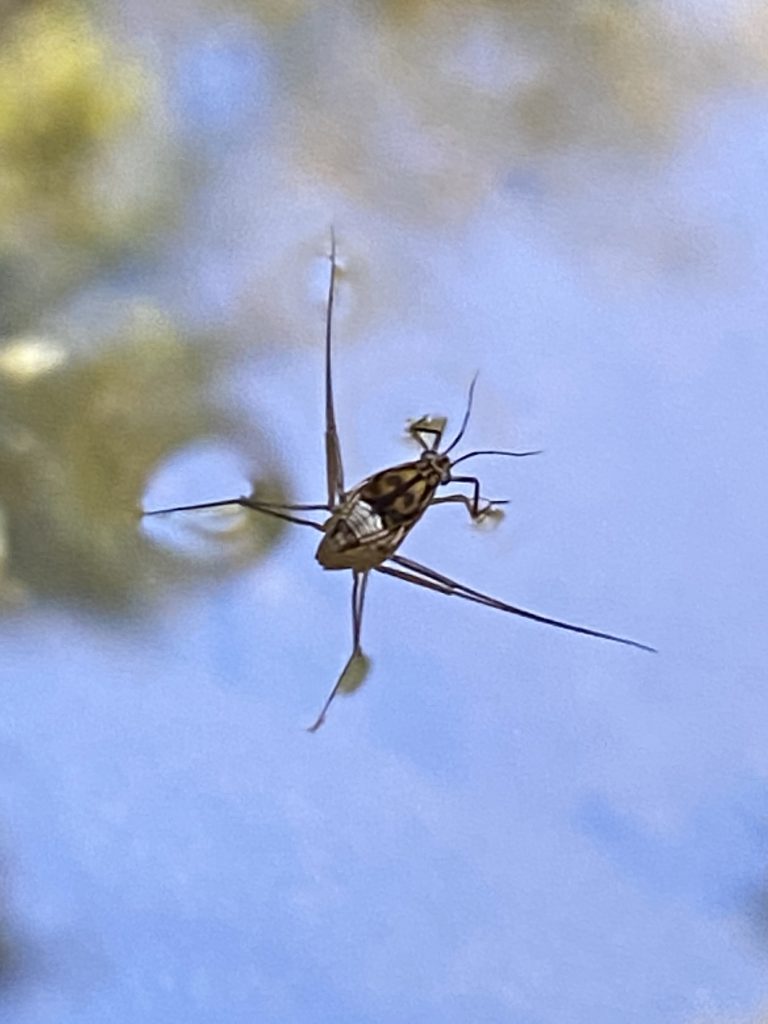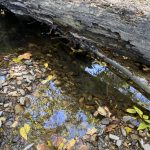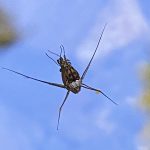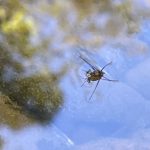
Water Strider
Waterbug Watching
Waterbugs. Everyone knows about them, but do you really know anything other than that they float on the water? Did you know that they are actually named “water striders” and that they are omnivores? Before my species summary, I did not know either of these things! As I began my sit-spot on October 5th around 3:45 pm, I was unsure what organism I would focus on. As I made my way to my private cove, I decided to be alongside Carvin’s Creek to the left of the decayed log I typically focus on.

Spot I Observed
At first, I wanted to observe the gilled snails but quickly realized the snails do little other than cling to rocks. All of a sudden, I realized my answer was not going to be under the water, but right on top! I chose these “Jesus Bugs” because I became conscious that I did not know much about these insects other than they could walk on water!

Water Bug
Honestly, I had never really examined a water bug and thought them to be just black specks on top of the water. In actuality, these bugs are different colors! The top half of their body is brownish-red with a black line going down the middle, and two black spots on either side. The bottom half is white with black lines running through it. Without the help of my camera, I would not have been able to see these details with the naked eye! Water striders have three pairs of legs, one of which I first mistook as antennas, which are extremely short and attached to the front. However, these insects do have antennas, just not as many as I originally thought. Also, the legs of the water striders are interesting in that the middle and back legs are attached to the body in close proximity, but branch out in very different angles! All sets of the legs are spider thin. For such a small bug, they are very detailed!
The water striders I observed stayed in an isolated pool of water that had little flow but was not entirely stagnant. Furthermore, these bugs are very active! For a short time, I just would watch an individual and count how long it was before they moved on the water, and found that these bugs typically move every 1 to 9 seconds. More commonly, these bugs jolted around every 3-5 seconds. I observed that these bugs have a very good sense of detecting their surroundings. It was very evident these bugs did not like to come into contact with other water striders or anything interfering with their space. If they sensed something, they would quickly move away!
After completion of my observations, I still had questions regarding the water striders or Gerris sp. First, I learned how these insects stayed afloat. On their legs, there are small hairs that repel water and capture air, which allows water striders to use surface tension to their advantage! This trait also allows water bugs to escape predators. However, if caught underwater, they would most likely drown. Their short front legs are used for food gathering, as water striders feed on plants and insects within their reach. Currently, scientists are researching the legs of these insects in hopes of being able to produce materials that easily repel water and flow along water faster!

Water Bug from a Distance
Although I knew what water bugs looked like from previous experiences, there was so much for me to learn. It was easy identifying this organism, the hardest part was trying to take pictures of it. They are so small and move rapidly, especially when something comes near, so it took me a while to finally get good pictures! My camera also had to focus in on them, which was hard at times, but very rewarding when I snapped detailed photos. Without these photos, I would never have been able to recognize their detailed backs and legs. I went back and forth between observing and taking pictures, which I believe helped me write a better description in my journal.
At first, I thought it would be boring to watch these bugs go in circles, but it turned out to be a very interesting experience. I enjoyed learning about a seemingly mundane insect and realized how fascinating they were atop the water. This was also a nice experience as it took a break from focusing on the entire area (although there would have been much to write about!) and instead observed a single object. I enjoyed taking notes in real-time as I could see how I was learning more about the characteristics of the water strider as time went by. I would love to do another species observation again soon!
I left promptly at 4:33pm. I am excited to return!

That’s so cool. I had no idea that they were different colors with patterns. Do you think the differences in these colors or the stripe and dot design on their backs has to do with their sex?
I really loved reading your post. It was interesting to know what you observed and saw, and I wish that my camera took great photos like your did. The only thing that I would recommend is that you add a references cited part because in the species summary that is required. Other than that I think you did an excellent job and your were very detailed in you description and I really appreciate it. I also want to add that you did not include the scientific name from what I saw, so what is the scientific name?